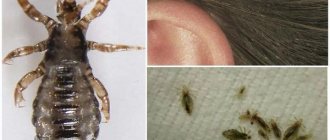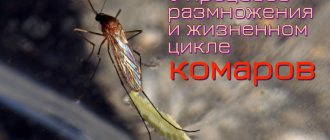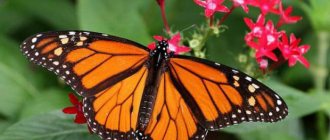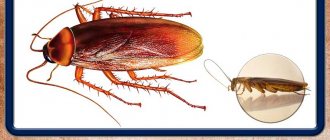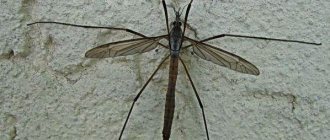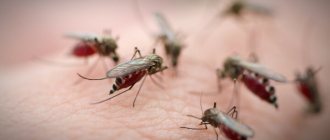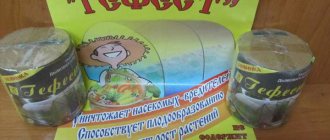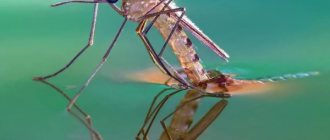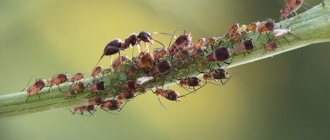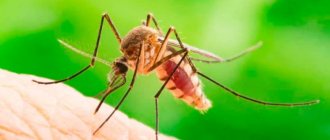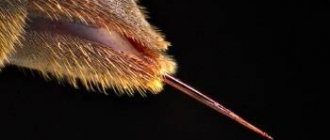Wasp life cycle, lifestyle
Everyone has encountered wasps at least once and is well aware of their aggressive nature.
The insect, without hesitation, will attack first if it senses danger. Predators are capable of not only stinging, but also biting with their jaws, which in itself is less painful. The family also has a herd instinct. If there are wasps nearby that sense the poison, they will come to the rescue and help attack. The entire short life cycle of insects can be divided into several stages:
- Birth and arrangement of the nest. With the arrival of warmth, the queen begins to nest to give life to a new generation;
- Reproduction. After laying eggs, fertile males and females emerge, ensuring further reproduction.
Every gardener, knowing why wasps are needed, will say that wasps only get in the way, because they spoil the fruit harvest, attack people and animals, and feed on the leftover sweet foods from the table. But they also destroy other pests that attack garden plots. In addition, they pollinate plants, which is also important.
All the nuances of appearance
The wasp belongs to the order of Hymenoptera insects, the suborder of stalked bellies.
The description of the structure of the insect allows it to be classified:
- The body consists of three clearly distinguishable segments - the head, thorax and abdomen, which are supported by a strong external chitinous skeleton.
- Between the chest and abdomen the insect has a long thin stalk, reminiscent of a narrow “waist”. It is this feature of the waist that defines the suborder. This structure allows the wasps to almost fold their body in half, and also sting the “enemy” from any angle. That is why, in fights with a larger opponent, these insects emerge victorious.
- The abdomen of the arthropod is covered with villi and has the shape of either a spindle or a barrel.
The question: how many eyes does a wasp have is not trivially simple. The striped insect, unlike the fly, is very “big-eyed” - the total number is five. On the sides of the head there are two large eyes of the wasp, protruding down beyond the plane of the stigma.
They have a very complex structure - they consist of a huge number of facets. As a result, the arthropod can look in different directions at the same time. At the very top of the head there are three more eyes. The upper part of the head is also decorated with a pair of antennae.
This organ is very multifunctional:
- perceives air vibrations;
- responsible for the sense of smell;
- is an organ of touch;
- has taste buds.
In addition, the wasp uses antennas as a measuring tool. When building a nest, she measures each cell with them. On the back of the wasp there are two pairs of membranous wings, which are fastened together. Therefore, visually, it seems that the insect has only one pair of wings. True, some types of wasps do not have wings at all.
Features and habitat
Wasp - belongs to the order Hymenoptera, and the suborder Stalk-bellied.
Wasps include insects such as:
- real;
- sand;
- wasps - shiners;
- road;
- scolias;
- wasps are German;
- Typhia;
- floral;
- burrowing;
- paper;
- hornet.
The wasp is an insect whose body is colored with stripes of black and yellow. The length of the insect (depending on the species) ranges from 2 cm to 3.5 cm. There are two pairs of wings on the back, but since the hind wings are tightly linked to the front wings, it seems that there are only two wings.
Wasp stings are painful, accompanied by swelling, and can cause a serious allergic reaction. At the same time, unlike bees, wasps do not leave a sting.
The eyes of this insect consist of many facets that allow you to look in different directions at the same time, and protrude down beyond the plane of the stigma.
In addition to the complex, compound eyes, the wasp has three more eyes, which are located at the very top of the head. It’s hard to believe that such a small insect is so big-eyed, but if you look at the wasp in the photo, you can easily see this.
The photo shows three additional wasp eyes.
In addition to huge eyes, there are also antennae on the head. These antennae are multifunctional. They are also organs of smell and touch, they also perceive air vibrations, they also act as taste buds and, moreover, when building a nest, each cell is measured with antennae.
Only female wasps have a sting. This is explained by the fact that this organ is an ovipositor and only when there is danger, the wasp injects poison through it.
The types of insect wasps are quite diverse and there are many of them, but they are all divided into social and solitary. Already from the name it is clear that solitary wasps prefer to live separately, without large companies.
They don't even build nests. But every single wasp has the opportunity to continue its genus, that is, to reproduce. But social wasps cannot live alone; they live in families, the number of which can number several thousand wasps.
Such wasps build themselves a serious home - a strong and reliable nest. Unlike solitary wasps, social wasps cannot all reproduce. Only the queen and males can participate in reproduction; the rest of the wasps are sterile.
In social wasps, nest construction begins with the queen. She can build a small dwelling, no larger than a walnut. She essentially needs a small nest where she can lay her first eggs.
First, the housing is all in one layer. But later the uterus builds up other tiers. It will work until young, working wasps hatch from the eggs.
And now they continue construction, freeing the queen for the most important task - increasing the aspen population. By the size of the nest, you can determine how rich the family is in workers.
Single wasps are not too sophisticated about building a nest, and if they do build one, then they have quite a lot of different methods of construction. Some build small cells in places protected from the weather and from prying eyes, and, for example, pottery wasps build something like a vase out of mud, which is attached to a wall or to tree branches.
There are wasps that simply burrow into the ground or bite through the stems of plants in order to find shelter there, and there are also those that prefer to find small crevices suitable for them to live. For such individuals, everything that remains from a person is also suitable - abandoned work gloves, pieces of three-layer cardboard, unnecessary things, etc.
Solitary wasps lay their eggs exclusively in a single cell and then seal it. In this case, there is no interaction between adult wasps and larvae.
It was also noticed that eggs are laid in smaller cells, from which male larvae later hatch. This means that they have fewer males than females.
The photo shows a clutch of wasp larvae
A variety of wasps live wherever possible. However, most of all they like to settle next to a person. This is understandable; humans are a constant dining room for these insects, where they do not need to make any special efforts to obtain food.
Variety of species
The wasps that are familiar to most of us and have yellow and black stripes on their bodies are called paper wasps. This species name is due to the fact that the material from which insects build their homes is very similar to paper. It is made from wood fibers chewed by arthropods, which are glued together with saliva.
Other types of wasps have different colors. The size of the insect depends on its species. They range from 1.5 cm to 10 cm. What do wasps eat? The adult eats mainly liquid food - nectar, fruit juice. For their larvae, wasps get: flies and other insects. Predatory wasps themselves eat insects, and can also feed on other types of food.
The wasp catches its prey and injects its poison into it through its sting, which does not kill, but only paralyzes. Thus, the meat of the prey is kept fresh until the time of the meal.
Different types of wasps live almost everywhere. For example, ground wasps choose soil to build their “homes”. Paper wasps build their “family nest” under a tree branch or on any structure. It should be noted that wasps are very willing to settle near people. This proximity makes it much easier for them to find food.
The wasp eats sweets and other foods left in a visible place in a person’s home. But also, it catches pests there such as flies, which carry various infections and thereby brings benefits. In the garden, wasps can find not only flies and ants, but also a huge number of insects that are pests. Wasps love honey very much and therefore pose a threat to bees.
The queen is the largest individual of the paper wasp family. The length of its body is approximately 20 millimeters, while the body length of a working wasp or drone is about 18 millimeters. Females have a larger abdomen than males. Insects do not differ in body color by gender. Males and females have the same yellow and black striped color.
Forming a Helping Family
The nucleus, which will strengthen the main family, deserves a separate story. It is located in the second compartment of the hive, and acts as a helper family. Strengthen it this way:
- One frame of printed brood is placed in it.
- Two weeks later, they do the same thing, but they put up a couple of frames, or they pour in the young ones.
- After the nucleus gets stronger, it is moved to a new home, which is located next to the main house.
In beekeeping in bees, this option is also practiced: the main nest is reinforced only by part of the helper family. The other part of the insects lives independently, grows stronger and develops. She serves as an assistant and, if necessary, strengthens weak families.
Lifespan of wasps
How long wasps live usually depends on many factors, but most of all on their hierarchical arrangement in families. Working individuals, as a rule, die the fastest; the life cycle of the queen lasts longer.
The presence of alternating black and yellow stripes along the body is a distinctive feature of wasps. Insects also have membranous wings, antennae, which are also considered respiratory organs, and powerful jaws. Depending on the variety, the dimensions may vary, for example, for a burrowing wasp, a normal length is considered to be from 5 to 20 mm, for a scolius - from 10 to 100 mm.
Wasp
Important! The presence of poison in these insects is indicated by their bright colors. The sting is an ovipositor with a modified appearance, considered characteristic only of females, they are the ones who are able to attack.
Wasps have never been long-lived. Their life depends on many factors related to the environment and the species. Social families of wasps live according to an internal hierarchy, which affects not only the distribution of responsibilities, but also the period of life. Each individual in the family performs its own functions and is distinguished by its significance. Within families, the following types are distinguished:
- queen - manages the colony and lays eggs to raise offspring;
- females that are unable to lay eggs are considered worker wasps;
- females that can conceive offspring at certain times of the season.
Polista, or paper wasps, are considered popular representatives of the subfamily. Spring is the time for the young queen to find a nest and begin building it. To build a place for offspring, chewed grass and tree bark are used. When summer comes, the first offspring of working insects are born, which resemble the queen, but are smaller in size. Such a brood can live up to two months. Towards mid-September, individuals appear in special cells whose reproduction is capable of producing young wasps.
Polista or paper wasp
When it gets cold and winter comes, the males begin to leave the nests and die. In general, they are able to live up to 3 months. Queens overwinter under the bark of trees, in crevices and grassy debris. Thus, the lifespan of a wasp can extend up to 4 years. In general, the wasp’s life period is associated with warmth, since only certain members of the family are able to survive the winter in frosty conditions.
Birth and nest construction
Wasps are not noticeable in winter and early spring, but with the onset of stable warmth, the first scouts fly out. These are future queens who, since last autumn, have been storing in their bodies the sperm of the males who fertilized them. Insects look for the first flowers to feed on nectar. The young female will have to fulfill the main function of her life - to give birth to a new family. She finds a suitable place and begins building a nest. The material is chewed tree bark, generously moistened with saliva. After drying, the substance becomes like thick paper.
Reproduction
The future queen builds a honeycomb, in the cells of which she lays eggs. After a few days, carnivorous larvae appear, demanding meat food. During this period, the female is actively engaged in the destruction of tree pests; they serve as food for the growing larvae. The first wasps are sterile females and will assist the queen in caring for the next generation and building the nest.
In August and September, young queens and males will appear ready to mate for reproduction. After fertilization of females, most males die. Old queens that have lost the ability to lay eggs will not survive the second winter. They will die along with the workers. Among the many species of paper wasps, there are females whose life cycle is 2-4 years. They enter a state of winter sleep several times.
Information. What do wasps eat in winter? Before the onset of cold weather, females try to accumulate more nutrients in the body. After entering diapause, they become so passive that they survive the winter due to accumulated substances.
Lifespan
Various representatives of the wasp family can live from a couple of months to several years. Species and external natural factors influence how long wasps live. Wasps are conventionally divided into solitary and social; their life spans are different.
Social ones live in a strict hierarchical system, like bees. Singles lead an isolated existence.
Uterus
The long-lived female among social wasps of all species lives for several years. All summer, the queen actively replenishes the population of the nest, continuously laying eggs. Towards the end of August, new, large cells for special offspring appear in the nest. From these cells young females and males hatch.
Before the onset of cold weather, they mate, after which the males die, and the future mothers of the family look for a place to winter. Females hide under bark, remnants of grass, and leaves. How many years the queen will live depends on a well-chosen location. Smart and lucky ones will survive 3-4 winters.
Working individual
Workers are the main population of a wasp hive, females who are not capable of reproduction. The working individual lives for about two months, the composition is constantly updated due to the continuous work of the uterus. By the end of summer, construction is no longer required; the worker wasps have completed their function. They restore order in their summer residence by eating larvae that have not yet been born.
After the act of cannibalism they set off on a journey. With the onset of the first frost, everyone dies. There are theoretical data according to which the queen of some species of the wasp family leaves the nest, dying along with the workers.
Males
In the tough wasp matriarchy, males are not particularly favored. They are born to fertilize females at the very end of summer; with cold weather, certain death awaits them. The lifespan of a male is about a month, with a maximum of 40 days. It all depends on the time of frost.
Why are wasps needed in nature?
Wasps, unlike their striped relatives, have not received enough respect from people. This is largely due to the fact that few people know what wasps are needed for in nature, because they do not produce honey, sting and even cause allergic reactions. It is quite logical that the question arises what wasps do, and whether they have any benefit for people and the environment.
Benefits from insects
What benefits do wasps bring:
- They destroy small bugs. The adult feeds on nectars and fruit juices. The wasp larva must eat protein to develop. To feed their offspring, wasps need to hunt pests, these can be flies, mosquitoes, aphids, spiders and other pests living in the garden;
- They destroy the mole cricket. Insects are able to drive the pest out of the ground, then paralyze the victim by injecting poison. Now the paralyzed body of the mole cricket becomes a kind of incubator. All this time, the pest remains alive, does not allow the wasp larvae to die, constantly feeding them with the necessary components. The mole cricket meets death immediately after the last moult;
- They pollinate plants and flowers. For full development, many plants need to be pollinated, which wasps do very well;
- Used medicinally to fight cancer. Scientists have proven that Brazilian wasps have a poison with a unique composition that helps destroy cancer cells without damaging healthy areas;
- Protect weak insects. Knowing about the ability to bite, hunt and show aggression towards other insects, weak individuals took on the colorful color of predatory insects. This is due to a subconscious reluctance to encounter wasps. Stripes save the weak from birds, some varieties of flies, beetles, butterflies and many others.
Wasps may not be as useful as nectar-producing bees, but don't underestimate their potential. Where wasps live, a significant decrease in flies, which spread various bacterial diseases with their paws, has been noticed. There are also fewer pests in the garden that spoil the crop, and the plants are not treated with chemicals. In addition, in order to attack a person, the wasp must see in him danger and aggression in its direction.
Important! When you see insects, you shouldn’t wave your arms, panic, or even cover yourself up. Wasps perceive all this as a threat to their lives. In other cases, they will simply fly by.
How do they reproduce?
Towards the end of the warm period, workers add large honeycombs to the nests. All this is necessary for the queen to lay eggs. Then, within 20 days, females and males are born, which are called drones. By the end of August, the young offspring need to be well fed in order to get stronger. All this time they are protected by the roof of the nest. With the arrival of autumn, drones begin to mate. At one time, the male fertilizes the uterus with so much biomaterial that she can lay eggs throughout her life.
Reproduction of wasps
The predecessors of drones are not able to survive frosts, so they die. After the wasps reproduce, the young female is able to fall asleep, lay eggs again when spring arrives, and reproduce. Moreover, during all the warm months, only worker wasps are born. Fertile offspring appear only with the arrival of August. The timing of the mating season may also explain why wasps attack people for no reason and are especially active and aggressive towards other insects.
Nutrition
Wasps are predatory insects, although they are known to have a “sweet tooth.” You should not leave bowls of jam on the summer veranda after drinking tea; wasps will certainly discover this gift and fly here for a new portion. Wasps can lick nectar from flowers, or they can also snack on smaller insects.
And yet, one has only to remember the wasp-rider, and doubts about predation will disappear. This wasp looks for a well-fed caterpillar, sits astride it (like an equestrian), pierces the skin with its ovipositor and lays eggs in the body of the victim.
Later, the larvae will be provided with food, that is, this very caterpillar. Some wasps choose beetles instead of caterpillars. The Pepsis wasp (road wasp) even tracks spiders, attacking them, sometimes even in their own home, and lays its eggs in the body of this spider.
By the way, cicadas, which are larger than wasps, also feed the larvae. They are simply walled up in a cell with an egg and when the larva hatches, it will not starve.
What do they eat in summer
The diet and feeding habits of larvae and adults differ significantly. Thinking about what wasps eat, you might think that they are omnivores, but this is a mistaken opinion. There are quite a lot of things that wasps eat and will never touch. Moreover, they are quite picky when it comes to nutrition.
The most constant food for insects is fruit and berry juice, which ripens during the period of their activity. Such nutrition is the main source of energy. In addition, wasps love the insides of berries and are able to leave behind only the skin. This applies to plums, raspberries, strawberries, blackberries and grapes.
Representatives’ favorite products are also:
- Sugar;
- Honey products;
- Fruit varieties of jam;
- Sweet syrups.
In turn, the larvae feed exclusively on protein tissues, that is, on other insects. Suitable for feeding and development of future offspring:
- Slug;
- Butterfly;
- Spider;
- Caterpillar;
- Cockroach;
- Bedbugs and other insects.
Important! If there are hives with bee families nearby, there is a danger of the striped workers being destroyed by predators.
Wintering process
Wasps live in winter in places hidden from human eyes. In most cases, in wood. They can hide and sleep under the bark, in old stumps, abandoned hollows, and crevices. Snowy winters contribute to successful wintering. The thaw has an unfavorable effect when the ice cover melts, the cracks become open to wind and frost. Unfavorable weather conditions, as well as natural enemies, prevent insects from overwintering.
In the wild, insects become victims of birds and animals. Bears deliberately tear open old hollows and eat prey before the insects can get out in the spring. Whether or not wasps sleep in winter is a controversial issue. This is a unique condition, as a result of which activity is lost, metabolic processes slow down, and nutrition as such stops. Wasps become inactive during the winter and save energy. With the onset of warmth, they awaken and continue normal life activities.
Enemies
Wasps are killed ahead of time by insecticides used by humans to combat various agricultural and forest pests, directly against wasp families. Among the main enemies of common wasps are hornets, as well as some species of birds. In autumn, inactive insects are eaten by animals, spiders, and large beetles.
The lifespan of the wasp family also depends on weather conditions. Nests and hives are destroyed by floods, forest fires, and premature frosts. A wasp can live genetically for a long time, but in practice the lifespan is shortened several times.
Where do wasps spend the winter and when do they wake up?
We have already said where wasps spend the winter. But the above did not apply to old females, who are practically no longer able to bear offspring. They do not look for wooden structures, stumps and leaves to survive the winter safely. Old females scatter, as they say, “wherever they look.” And as soon as the temperature drops below zero, they become completely inactive. The result is immediate death. Such is their lot.
But the surviving wasps are waiting for fifteen-degree heat. And, having gained strength, they leave their winter homes. Now the main goal of the wasps is to build a nest. We advise you to get together with all your household members in the fall and carry out preventive cleaning of the area. Believe me, it will not be superfluous. This way you will destroy the “secret hiding places” of insects in the same accumulated foliage.
Where do they spend the winter?
When daylight hours and air temperatures decrease, the wasp family begins to look for a place to winter. The best place for wasps to hibernate is under the bark of trees, as deep as possible. You can also hide in an old stump, under leaves that have fallen from trees, and in the crevices of buildings.
Winter houses for wasps
As soon as the first cold weather sets in, summer residents calmly remove and burn wasp nests. They know very well: the insects have already flown away. In fact, the destruction of empty nests only has a certain preventive role. The fact is that wasps like to nest where there are already other wasp nests nearby. And it’s better to get rid of the old nest: suddenly the wasps won’t come again!
Before wintering, females actively mate, and then fly away in search of a suitable place for wintering. What attracts insects, and where do wasps usually hibernate? They love fallen trees. Rotting stumps also become a home for wasps. If a good litter has been formed from fallen autumn leaves, insects will definitely live in it and stay there until spring.
Females, for the most part, look for cracks in the bark and climb into them. If there are a lot of cracks in your country house, then insects can get into them and stay there until the first warm days. The main thing is that wasps do not end up on the inside of your house. Any wooden buildings, especially old barns, can become an “apartment” for insects. And you need to be prepared for this.
There should not be large temperature differences where wasps hibernate. When there is a harsh winter or, conversely, little snow, many females die. Even before they have time to recover from hibernation, wasps become desirable prey for birds, which cannot help but take advantage of the arrival of winter thaws. But, naturally, some insects remain alive. And the new generation appears quite quickly, which in any case has a positive effect on the population.
Wintering places
In the summer, wasps can be found almost everywhere in nature. Before the fruits ripen, these insects actively eat pests. Their numbers are usually small. However, as the fruits ripen, the number of insects increases.
The first young wasps are sterile females. They help the queen care for the new generation and build a nest. At the end of summer - beginning of autumn, young queens and males mate. With the arrival of cold weather, the nests quickly become empty: most of the male and working individuals die.
And young females choose places that are completely hidden from human eyes as their winter “dwelling.” In most cases, this is the thickness of wood, old stumps and cracks in outbuildings or houses.
Features of wintering
Insects begin to arrange winter shelters when the air temperature drops to + 10 degrees. During this period, already fertilized females try to occupy the deepest places.
Many people are interested in how wasps overwinter in the wild. When real cold comes, their body accumulates quite a lot of special cells that play the role of antifreeze. They lower the freezing point and prevent the body's cells from being destroyed under the influence of low temperatures. Insects tolerate snowy winters best.
Do wasps hibernate? This state is called diapause. All metabolic processes in the body slow down, external nutrition completely stops. Insects become drowsy and inactive. Insects obtain the necessary substances from their own body reserves. Wasps do not gorge themselves especially before winter. Everything that they accumulated in the body over the summer becomes a source of food for the whole winter. Awakening begins when the temperature reaches +10 – + 15 degrees.
How long does a worker bee live?
Although worker bees provide the most benefits, their life span is very short. Since such insects constantly work, their life cycle is shortened and thus they live less. The average bee lives from 28 to 180 days. In very rare cases, the age of the insect reached 1 year.
If the colony multiplies in summer, then such a bee lives for a maximum of a month. If the brood was produced in winter, then with proper feeding they can live up to 180 days.
In cold times, and especially in winter, bees must be constantly inspected. Insects cannot tolerate prolonged cold. If the beekeeper has tried and looked after the evidence all winter, then at the beginning of spring his evidence will be without much loss. In case of neglect, you can lose your entire family.
If a bee colony does not increase in size and does not produce offspring, it can survive for about 12 months.
When the bees are sealed for the winter, the bees eat their reserves of honey, beebread and pollen. During the winter, bees need to leave several frames of honey. Otherwise they won't survive. Many economists feed the colony with sugar in winter, thereby reducing the life of a bee by 30%.
Since the evidence is one living organism consisting of many insects, all kinds of diseases cannot be excluded. For example, a weak family is more susceptible to diseases such as viral paralysis, varroatosis, etc. Whereas strong bees will be able to survive until the next brood.
There are no lazy bees, so they all work equally well. Which is why the lifespan is also the same.
Dangers of wintering
Not all queens will be able to meet spring. While they sleep with their paws and wings tucked in, they are in danger in the form of animals and birds left to spend the winter in the forests. These natural enemies of wasps find and eat insects.
Interesting fact. During the summer, a colony of wasps builds a large nest, which has protective shells and is characterized by low thermal conductivity. But insects do not stay over the winter in their home; they never return to it.
The danger of wintering
During hibernation, wasps face many dangers. One of the main ones is animals and birds. In the spring, bears destroy stumps and old hollows in search of food. This happens before the insects wake up en masse. Birds also peck at wasps that have settled in hollows or forest floors of dry leaves.
Another danger is unstable weather conditions. With sudden changes in temperature from frost to thaw, the chemical composition of cells changes. During the next cold snap, the mechanism that prevents the crystallization of the liquid does not work, and the wasps die. Abnormally low temperatures are no less dangerous. In very severe frosts, the bodies of insects completely crystallize, causing them to die.
The life cycle of wasps is a complex and interesting process. What these insects do is an integral part of the biome. Death and rebirth are repeated endlessly so that the wasp population does not disappear on our planet.
How do wasps overwinter in nature?
In the fall, as daylight hours decrease and the temperature drops, the wasps begin to seek shelter. The best choice is to dig deeper under the tree bark. It's warmer here and it's harder for birds to get to. Females can hide in old stumps, under a pile of fallen leaves, or hide in the cracks of outbuildings. Insect lovers are wondering – do wasps sleep in winter or not? During the period when insects cannot satisfy their needs, they fall into a lethargic state.
Metabolism practically stops, the body becomes insensitive to low temperatures. The body of hibernating queens produces a component with properties similar to antifreeze. It helps wasps survive frosts. For a safe awakening, it is important to avoid sudden temperature fluctuations. Untimely warming is detrimental to females. The chemical composition of the cells changes, due to which during subsequent cold snaps the mechanism that prevents the crystallization of the liquid is lost.
Information. At abnormally low temperatures, which are not typical for temperate latitudes, the body cells of wasps crystallize. This irreversible process leads to the death of the queens.
How wasps overwinter in nature
In autumn, when the length of daylight hours noticeably decreases and the ambient temperature drops, fertilized queens begin to look for secluded places for wintering.
They will be satisfied with old, peeling bark on trees and stumps.
, under which you can properly go deep, and where the birds will not reach them, various
cracks in outbuildings, accumulations of dry leaves, dumped boards, compost heaps
, etc.
The insects fold their legs and fall into a kind of hibernation. Over the course of a long winter, they will slowly use up the reserves accumulated from summer-autumn (this is why wasps are so annoying in late summer-September).
Interestingly, the body of wasps in winter produces a substance whose properties resemble antifreeze. Because of this, they manage to remain viable even in severe frosts.
Where do wasps spend the winter in nature?
Many people are interested in where wasps spend the winter. Usually, before the start of winter, wasps begin to actively mate. After this, they leave in search of a place where they can spend the winter. What attracts these insects most? They prefer fallen trees; many like to spend the winter in rotten stumps. They become a place of hibernation for many wasps. The same can be said about autumn leaves. They form excellent bedding that both females and males love. That is why, in order to overwinter in the autumn leaves, they have to fight other insects.
Female wasps spend the winter in cracks in tree bark. They feel quite comfortable there. It is really easier to winter in these places. If there are too many cracks in a house located on an area with these insects, then the wasps may remain overwinter there. The main thing that everyone who lives next door should remember concerns their wintering place. Under no circumstances should they end up on the inside of the house. In addition, these insects often prefer to winter in old barns, as well as in any other wooden structures.
Insects are very picky about where they live. They do not like large temperature changes. That is why the place where wasps overwinter is chosen with special care. The fact is that a harsh winter or little snow can cause the death of many females. Moreover, these insects often become easy prey for birds.
Wasps do not like to hibernate, since winter is a dangerous time not only for them, but also for any other insects. Despite all the hardships, a significant part of the females still survive after hibernation. The new generation appears quite quickly after the end of wintering, so today this species is not threatened.
How social wasps overwinter
This is how we spend the winter.
Many people do not even suspect that wasps are divided into social and solitary individuals. Just one name is enough to understand the difference between these two types of wasps. Social individuals live in entire families. In this they even resemble people. Single individuals live separately from each other. It is important to note that this division is present in many insect species. Typically, wasps that lead a solitary lifestyle first mate and then lead an extremely solitary lifestyle.
Females build nests and then leave a small supply of food there for the larva. Usually small spiders and other insects act as food. Once the cell is filled, the female seals it. Then the larva eats the food prepared by the mother and develops right inside the cell. Then the young individuals scatter around the area and look for where they can build their own nest. Despite the fact that single individuals live separately from each other, they also reproduce. By the way, in wasps, only the uterus can continue the birth.
So how do wasps overwinter in nature? Overwintering in nature can be very difficult. Wasps do not feel their best in the autumn-winter period. The fact is that hibernation is the lot of young and fertilized wasps. Males die immediately after fertilization. Sometimes, after the onset of cold weather, the entire wasp family, abandoned by young males and females, dies. The death of a family means the death of the queen and worker wasps, who also lived in the old nest. The fact is that working individuals live only 4 weeks. The uterus can live as long as 10 months. Where do young wasps spend the winter? They usually look for a secluded place where they can spend the winter. Only after a warm place is found do the insects fall asleep. They can only wake up in the spring, when the air temperature becomes higher. Female social wasp species can only be fertilized by a male once. After wintering ends, they begin to look for a place for a new nest.
Poisoned Dew
“Russian families who have been engaged in beekeeping for generations are going bankrupt,” continues R. Klochko. – For example, in the Oryol region. Artsibashev family has had its own apiary since 1946. This year they lost it: 70 families died, the damage is estimated at at least 1.5 million rubles. Or I received a letter from the father of 4 children. The apiary was the main source of income for their family. After the death of the bees, they gave up: is it worth getting new ones? They can also be poisoned. I know that some beekeepers have already written a letter to Vladimir Putin .
When wasps go to bed
Many people wonder when wasps go to bed, and whether they sleep at all. When touching on this issue, it should be taken into account that at a time when insects have nothing to eat, they hibernate. At the same time, their metabolism freezes, and the body does not feel temperature changes.
Important! The body of the uterus provides it with a substance whose properties resemble antifreeze, which prevents it from freezing even in severe frosts. In such cases, a smooth change in temperature is necessary for survival to avoid death due to awakening too early.
Also, wasps always care about where they will spend the night. These can be tall plants and grasses, to which they are attached individually with their jaws and paws. Rarely, but there are cases when insects spend the night in a group.
When wasps wake up after winter
Insects will wake up only in the spring, when the air temperature rises to +14 C.
The queen will lay the first layer of a new nest with a small number of cells on her own. The material for construction is crushed tree bark, generously mixed with insect saliva. When the composition hardens, it becomes like parchment paper.
Without wasting time, the queen lays eggs in the first formed combs. When female workers emerge from the eggs, they completely take over all construction work. The uterus can finally focus solely on reproduction. Subsequently, the size of the nest can be used to judge the size of the colony.
Spring troubles of public wasps
The female of a social species is fertilized by the male only once. Having overwintered, she begins to look for a suitable place for a “family nest.” This could be a tree branch or the ceiling of a building. In the spring, she must build several cells that will be connected to each other - this is how they get honeycombs. She lays one egg in each cell.
The eggs develop very quickly - in about a week. The queen feeds the larvae that emerged from the eggs with chewed insects. The larvae, covered in cobwebs, turn into pupae. A few days later, worker wasps emerge from the pupae - these are sterile females. Already in July they take upon themselves the responsibility of completing the “house” and taking care of the mother and the larvae.
From this time on, the uterus is engaged only in laying eggs. After all, she needs to put aside about 300 pieces a day. In addition, she carefully monitors the order in the house. It often stings workers who do not perform their duties well. All workers are sisters to each other, and the female team needs an eye and an eye.
Summer-autumn period
Experts say that it is the food that the larva eats that determines who will emerge from it - a working disembodied individual, either a female or a male. The queen lays eggs only at the end of summer, from which insects capable of reproduction will hatch. They are fed food that promotes the development of reproductive organs.
What does it consist of? This can be chewed pieces of leaves and other plant foods, as well as “meat” in the form of various insects. In particular, flies, beetles, spiders, etc. The wasp larva does not leave the cell until it becomes an adult. Having reached maturity, the insects swarm and mate with each other. Thus, the life cycle begins anew.
Who destroys wasps' nests
In addition to people who do not like living next to wasps, their houses are often destroyed by wild animals and birds. It is especially common to see tits pecking at last year’s wasp’s nest.
Wasp nests can become a source of discomfort and irritation for those whose home they choose as their place of stay. Therefore, it is better to take preventive measures in advance to avoid an inconvenient and burdensome neighborhood.
All social wasps build their homes from a type of paper that they produce by chewing wood or plant fibers. Other wasps attach their nests to the walls of houses, tree branches or rocks.
Lonely wasps don't build their nests out of paper, but they have many other options. Ground wasps, for example, dig long, narrow holes in the ground. Carpenter wasps prefer to build their homes in wood. There they make tunnels, bring the succulent bodies of some insects into them, lay eggs, and then fly away to another cell.
https://upload.wikimedia.org/wikipedia/co…
Pottery wasps lay their eggs in small, pitcher-shaped cells made of clay. Each of them is attached to a branch. Mud wasps make small cup-shaped cells out of mud and attach themselves to buildings or rocks. One type of ground wasp is the only insect that uses a tool to build its nest!
They carefully cover the cell and then trample the ground with tiny pebbles, which they hold in their jaws.
https://content.foto.mail.ru/mail/osernay…
Wasps and hornets build spherical nests. Hornet nests are not as strong as those of wasps. The nests also differ in color. To prepare the “paper” used to build a nest, hornets gnaw the bark from young, usually birch, branches, so the “paper” is brown. Wasps have gray nests. The wasp scrapes off old, rotten wood on dry trunks, stumps and even fences, leaving longitudinal grooves.
https://img0.liveinternet.ru/images/attac…
Hornets build their nests in shelters - in hollow trees, caves, birdhouses, and often settle in the attics of houses. In large hornet nests there are twelve layers of cells superimposed on each other, with a total number of five thousand or more, and the largest nests reach 40-50 cm in diameter and 50 cm in height
https://turizm.lib.ru/img/k/kwachew_l_j/v…
Wasp nests are placed on tree branches, under overhanging rocks or roofs of houses. The nest, attached to a branch, consists of cells with larvae, attached to a common rod, and covered with layers of paper. As the family grows, the nest grows and expands. Some wasps build cells without a shell. The nests of many types of wasps are located openly on tree branches and on rocks: there is no need to camouflage them; what makes a paper city strong is not the walls, but the guards.
In a spherical nest, hexagonal honeycomb cells are attached to each other, with the open hole facing down. The female wasp lays an egg in each cell and begins to feed and protect the larvae that appear a few days after laying.
The nest exists for one summer. Males and workers die in the fall, and fertilized females remain to spend the winter. The overwintered female begins building a new nest. The insect carefully chews the bitten off piece of bark, mixing it with saliva, forms a small ball from the resulting mass with the help of its front legs and returns with it to the nest. The extracted building material is suitable for both honeycombs and the shell of a home. Turning the balls into plates, the hornets paste them over the walls of the shelter. First, the female builds the first tier of comb from several downward-facing hexagonal cells, attaching them to the ceiling of the nest. Soon the queen begins to lay eggs, one in each cell of the comb.
When the family grows, a second one is suspended from the first tier of combs, etc. The expansion of the home always occurs from top to bottom, the entrance is located at the bottom.
Paper production
consists of many operations. It begins with finding the necessary source of raw materials, after which a logistics scheme is thought out, which includes delivery of wood, chemicals, water and energy to the production site. After this, the wood is thoroughly crushed, moistened with substances that ensure the formation of paper fibers and rolled into sheets of the required width.
Wasps, producing paper for their homes, solve the same problems. Let's see how they manage it.
Wasp control work in the autumn-winter period
In the autumn and winter, owners of vineyards and orchards should not relax, waiting for the summer “attack” of wasps on fruit and berry crops. A number of works should be carried out in winter, so as not to waste precious summer hours, which are always in short supply.
- In late autumn, you should check places where wasps may have lived - attics, sheds, corners in sheds and others. Found empty nests should be removed and burned, and the places where they are attached should be treated with some kind of odor-reducing agent. Kerosene, machine oil, dichlorvos, etc. are suitable. This will not harm the insects, since the wasps have already left their nest, but in the spring, the awakened females will look for places to build a new hive. They like to settle near old nests. The absence of old hives and the intimidating smell will force females to look for other places to create a new family.
- With the onset of cold weather (below + 10 degrees), possible wintering sites for females should be collected and burned on the site - old rotten stumps, cut trees. The loose bark should be torn off from dried trunks. Piles of dry leaves should be burned and compost heaps should be poured with boiling water. It is advisable to stir up and turn over or move the boards, pieces of roofing felt and slate to another place. If the wasps have settled down for the winter under them, then, left without shelter, they will die.
- During the winter, you can collect empty plastic bottles and make traps from them. 0.7-liter jars with plastic lids are suitable for the same purposes.
- On free evenings, you can prepare bags for tying bunches of grapes. Gauze, unnecessary tulle or old thin tights are quite suitable for this.
- Preparations should be prepared to combat these insects. It is advisable to stock up on insecticides for baits and traps (boric acid, which is sold in pharmacies, can be successfully used), as well as sprays to destroy nests.
“Armed” in advance, it will be possible to begin the fight against wasps in a timely manner and prevent significant crop losses.
Fighting wasps in the autumn-winter period
Prepare your sleigh in the summer, and start fighting wasps in the winter. Just because wasps have left their nests for the winter doesn't mean they won't return in the spring. Therefore, certain work must be carried out while there is no one in the nests, or rather, as soon as the temperature outside the window drops to 9 - 10 degrees. This makes the task much easier.
First of all, it is necessary to carefully examine their possible wintering places - attics, sheds, all dark and dry corners. Look into every crevice where wasps could possibly live. If boards and other things are piled up on the site “just in case,” they should be moved to another place or rearranged. If wasps were hiding there, then if they were left without a roof over their heads, they would quickly die.
If you find a nest or something similar to it, remove it carefully and destroy it. The place where you found the remains of a wasp nest must be watered with something with a strong and pungent odor. Kerosene, for example, or dichlorvos. These measures will lead to the fact that next year the wasps will look for other nesting places. In addition, before snow falls, it is necessary to collect and burn fallen leaves, if possible, remove dry branches and trees from the area, or peel off the bark from them. Thus, we will significantly reduce the number of places where wasps can hide for the winter. The right owner will not forget to replenish supplies of insecticides. In winter, they are needed much less and, accordingly, their price is lower. Whether to collect plastic bottles for traps or not is something everyone will decide for themselves. Considering that almost all liquids are sold in such bottles, it is not advisable to collect and store them all winter.
Preventative measures against annoying neighbors
Paper wasps are troublesome neighbors. They spoil fruits on trees, bite people, and intrusively climb on sweet food. To reduce the likelihood of them settling near the house or under its roof, it is advisable to destroy the nest. Knowing what wasps do in winter, you can safely cut down the structure and burn it. At this time, you do not risk getting bitten by a stinging insect. Females do not settle in the old nest, but build a new one in their usual place. If you treat the area where the building was located with an unpleasant-smelling compound (kerosene, machine oil, dichlorvos), the queen will fly away to look for a more suitable shelter.
To deprive wintering wasps of shelter on the site, certain work should be done:
- collect and burn dry leaves;
- remove rotten stumps and cut trees;
- do not leave boards or slate sheets on the ground, under which insects seek shelter for the winter;
- pour boiling water over compost heaps;
- You can begin preparing material for the traps that will be needed to protect the crop.
Fighting stinging insects after the onset of cold weather is absolutely safe. They remain in a state of diapause until April-May. Only with the onset of warm weather (+14 0) will the queens wake up and begin creating a new colony. Preventive measures will help reduce the number of insects that survive until spring.
What happens if you kill a queen wasp?
The death of the uterus inevitably leads to the cessation of the family's existence. Working individuals gradually leave the nest, weak ones die of hunger. Empty shelters are often taken over by parasites. If there are any offspring left in it, they die from the invaders. Only young females survive, capable of reproduction, who will leave the shelter and manage to build a new one.
Diversity of wasps in nature
There are a huge number of wasp species in the world. All of them belong to the order Hymenoptera insects, which have two pairs of wings. The size of adult individuals is from 10 to 55 mm, with males being smaller than females. Their mouthparts consist of strong jaws that are capable of tearing apart prey and gnawing layers of bark from trees. A distinctive feature of wasps is a thin stalk between the chest and abdomen, a kind of wasp waist.
All insects belonging to this family can be divided into two main groups: solitary and social wasps. The former lead a solitary lifestyle, often building nests in the ground or not building at all, preferring to lay eggs on larvae and spiders. Social or paper wasps are common striped wasps that buzz around gardens and parks. They live in colonies of several tens to thousands of individuals.
Why are earthworms useful?
Earthworms are one of the most useful living creatures on the planet. Despite their unpleasant appearance, they are completely harmless, and their numerous populations make a huge contribution to the growth and development of all flora in the world.
Worms are real orderlies and healers for the soil. The main benefits of these animals are as follows:
- enrichment of soil with useful substances and microelements;
- disinfection and deodorization of soil;
- restoration of fertile soil layer;
- accelerating the processes of decay of plant residues;
- loosening the soil;
- vermicompost production;
- promoting the colonization of beneficial microorganisms in the soil.
Interesting facts about wasps
In the fall, they scatter around the surrounding area and after that they no longer show their former activity and become much more vulnerable, sleepy and inactive. The fate of each individual individual develops differently. Some of them simply live out their lives as summer ends. After that they freeze.
If we are talking about fertile and fairly young females, then they usually mate at the very end of August, and then simply sleep in a secluded corner. This is necessary in order to continue life after the onset of spring (with the onset of heat). At the end of the season, the males die, as well as the working females and the old queen. It also happens that fertile females are born only at the very end of the season.
Another circumstance that has a strong impact on the situation with these insects is the slowdown of metabolic processes in the body of the uterus. After this, preparations for wintering begin. The body temperature of these insects begins to drop to a minimum level, which will help cope with freezing on too cold winter days. Wasps in winter are able to withstand even the harshest conditions if they manage to find a secluded place.
Sources
- https://7ogorod.ru/prochee/skolko-zivut-osy.html
- https://eparazit.ru/gde-zimuyut-osy.html
- https://beetlestop.ru/gde-zimuyut-osyi/
- https://apest.ru/osy/ob-osah/zimuyut-osy/
- https://sesrus.ru/gde-zimuyut-osy
- https://DomPchel.ru/pchelovodstvo/poleznoe/kak-zimuyut-osy/
- https://www.dacha6.ru/gde-zimuyut-osy-givuschie-pod-kryshei/
- https://queenbee.ru/osy-shershni-i-shmeli/gde-zimuyut-osy
- https://vredstop.ru/osy/gde-zimuyut-osa.html
[collapse]
Larval development
The female lays each egg in a separate cell. After a few hours, a larva appears - a thick, legless white worm. Sedentary, absolutely unable to take care of herself. It feeds extremely actively and requires exclusively protein foods for development. After 14 days, the larva weaves a cocoon and closes the entrance to the cell. It stays in this state for about a week. Adult adults fly out from there and immediately begin to perform their duties.
Interesting!
In some families of wasps, young females help replenish the colony. They lay eggs, but do not claim to be the queen. However, in the event of the tragic death of the uterus, it is calmly replaced. In such a swarm, fertile females and males are born not only at the end of summer, but periodically throughout the season, ready to mate at any time. The wasp family is called Polista.
How a wasp feeds larvae is a very fascinating process. Chews the insect, forms small balls, and feeds it to the young.
